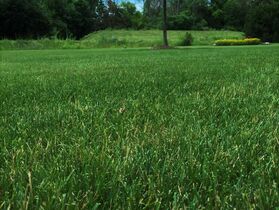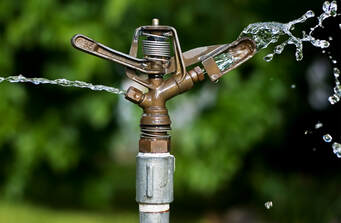 This is a Q&A blog series on healthy organic turf. If you have a question for Good Sweet Earth's lawn guy, Steve, shoot him an email at steve@GoodSweetEarth.com, and include "Ask the Lawn Guy" in the subject line. I got this question via email last week: Give me one good reason why I should have an organic lawn. Modern science has given us tools to have a green lawn without weeds, why shouldn't I use them? I can do better than one good reason, I can give you three. First, healthy grass comes from healthy soil. Synthetic chemical fertilizers kill your soil, which in turn kills your turf and makes it overly reliant on chemicals. Dead, sterile soil is also a breeding ground for weeds and disease. Organic fertilization focuses on feeding your soil and developing a healthy ecosystem of bacteria, fungi, worms and other life below the surface of your yard. We use vermicompost (nutrient-rich compost made by earthworms), microbial tea (a liquid rich in microbes to help break down organic matter in your soil), and all-natural slow-release fertilizers. Modern science may have convinced us we can only grow a healthy yard with synthetic chemicals, but nature itself has given us the most effective ways to grow things: water, microbes and organic matter. We've only had synthetic chemicals for our lawns for about 60 years, but things grew just fine for billions of years before that. Second, many people in the United States have made the switch to buying organic produce, yet continue to dump chemicals on their lawn and garden. There's a real disconnect there. If you're concerned with how your food is grown on a farm, you should be even more concerned with how your grass (and garden) are grown in your own yard. If you don't want your family exposed to chemicals on the foods you eat, why would you want to expose them to chemicals in your yard? Third, synthetic chemicals are destroying our ecosystem. These chemicals leach into our watersheds, they kill the life found in our lakes, rivers and streams, they cause algae blooms, and ultimately introduce poisons into our environment. Organic soil management practices can reduce the effects of climate change by helping soil hold on to carbon more effectively. This type of healthy soil management doesn't have to be limited to farms, it needs to start right in each of our yards. In fact, lawns cover more acreage in the United States than any other crop. That means the management practices adopted by homeowners could have a larger impact on our nation's soil and climate than the actions of our farmers. If you live in Kent, Ottawa, Allegan or Muskegon Counties in West Michigan, and you'd like to learn more about organic lawn care for your own home, give us a call at 616-594-0693 or email us at office@GoodSweetEarth.com.
0 Comments
Rain or shine (or whatever Michigan's skies give us), join us at Wedgewood Park, 3301 Wilson SW, in Grandville this Saturday, April 20, from noon to 3pm.
We'll be there to answer any questions you might have about organic lawn care, as well as a fun activity for the kids. In addition to Good Sweet Earth, there will be a tree planting workshop, presented by the Grandville City Tree Board (noon-1pm); a workshop on native landscaping (1-2pm); and a rain barrel and rain garden workshop (2-3pm). There will also be native plant vendors on-hand (cash only), planting activities, special activities from the Friends of Buck Creek, games, and Grandville Mayor Maas' "Famous Organic Granola" for sale. Activities are free, and we hope to see you there!  This is the first in a Q&A blog series on healthy organic turf. If you have a question for Good Sweet Earth's lawn guy, Steve, shoot him an email at steve@GoodSweetEarth.com, and include "Ask the Lawn Guy" in the subject line. So the question of "How much should I water?" is a frequent one, which is why I've decided it tackle this one first in our "Ask the Organic Lawn Guy" series. And here's a simple answer: Water as often as you'd like, to keep your turf as green as you'd like, but make sure you water for at least 30 minutes at a time (ideally 45-60). Read on for a more-nuanced answer. First, we need to talk about turf in Michigan. We're in what's called a "cool-weather turf zone." That means our turf grows when it's cool, and it goes dormant when it's hot and when it freezes. And contrary to popular belief, grass shouldn't be bright green in the middle of summer, and you probably aren't going to be mowing it twice a week either. Michigan turf grows and greens in the spring and the fall. Then during the summer and winter, it gets brown and stops growing while it stores up carbohydrates for the next growing season. So, all that brown grass you see in the summer? It ain't dead. It's sleeping. If you don't mind having brown, crispy grass during the months of July and August, letting it sleep is probably the best thing you can do for your lawn. It'll have much more vigor and density in the fall. That being said, turf shouldn't go for more than three weeks (two in especially hot conditions) without water. So even if you go the dormancy route with your turf, you should still put the sprinklers on every two to three weeks (if there's been no rain). And when you do put the sprinkler on, let it go for about 45-60 minutes per zone. This will allow the water to go deeper into the ground, which will force the roots to grow deeper as well. This will give you stronger and more drought-resistant turf. But what if you don't want brown crispy grass all summer? What if you like to have some soft green turf to play on and admire? Then my advice to you is to let it get as brown as you're comfortable with, and then put the sprinklers on for 45-60 minutes. For some people, this might mean watering twice or three times a week. For others, it might mean once every 10 days. I don't have a hard and fast rule for how often you should water. Just do it when you think your lawn's getting too brown for your own comfort. If you're able to go 15 days between waterings (and let the grass go into a dormancy), great! If the thought of crispy turf makes you feel a little uneasy, go as many days as you can without watering, and then let the sprinklers fly. The only rule I have is to water for at minimum 30 minutes, but ideally 45-60, depending on how your soil can handle that amount of water (you don't want puddling). The one thing you do NOT want to do is a 10-minute watering. This will mean the water never goes very deep into your soil, and neither does your turf's root zone. And that's bad news. I've talked to too many customers who water their lawn every morning, seven days a week, all summer long, for 5-15 minutes a day. This is not effective for healthy turf. Watering at mid-day or in the evening is also bad. Why? When you water at mid-day, you lose a lot of moisture to evaporation. And watering at night can create a breeding ground for fungus on your grass. Mornings are the best time of day to sprinkle. Now, I have to mention that there's a real technical answer that turf professionals like to give when asked how much to water a lawn, and it includes the number of inches of water you should be applying, and then putting out coffee cans in your yard while you sprinkle in order to measure the amount of water, etc. But most of us aren't managing a golf course. If you go with what feels comfortable for your lawn, watch out for over-watering (puddles), avoid short watering periods, and avoid mid-day/evening waterings, you'll be fine. So to sum up: In the spring and fall, you can probably rely on rain to do all the watering your lawn needs, but if you do turn the sprinklers on, water deeply (at least 30 minutes). In the summer, go as long as you're comfortable going between waterings. If you don't mind grass that's a little brown, letting your turf go dormant is ideal for it's long-term health. Otherwise, turn the sprinklers on for about 45 minutes in the morning whenever you see your turf getting too brown for your own comfort.  Steve Veldheer, Certified Landcare Manager, NALP Steve Veldheer, Certified Landcare Manager, NALP We get a lot of lawn care questions tossed our way here at Good Sweet Earth, from topdressing and soil testing to fertilization and weeds to water and seeds. We're always happy to come out and give consults or answer questions via email or phone, but we also thought it might be helpful to post some responses to some questions (especially frequently asked questions) here on the Good Sweet Earth blog. So go ahead and shoot Steve your lawn questions-- chances are that if you're curious about something, somebody else is too, and this would be a great place to educate around organic lawn care. Send lawn questions to: Steve@GoodSweetEarth.com, with "Ask the Lawn Guy" as the subject line.  The website, Your Green Pal, has a great list of things you should have on-hand as the weather begins to warm and your yard starts to grow again. Best of all, their list is free of synthetic chemicals, so if you're going the organic route in your yard, this list is a must-read. Click here for their 2019 Spring Cleaning Buyers Guide. We also appreciate their including Good Sweet Earth on their list of things to purchase in the spring (#5: Soil additives from Good Sweet Earth). We didn't ask to be included, but we sure appreciate the shout out on a national website! |

